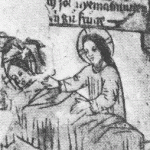Slate.com has a series by Tony Perrottet about searching for the sites of the 18th century Hellfire Clubs in Scotland, and their somewhat disappointing modern remains. As often is the case, exploring the past reveals a picture less sensational than one imagined, but also much weirder.
From the records, we can reconstruct a meeting held on Nov. 30, 1737—St. Andrew’s Day. In miserable weather (the minutes read: “Tempest”), two dozen members, from customs clerks to local gentlemen, gathered in the fire-lit room wearing olive green silk sashes and pornographic medals. On a table in the center of the room, a pair of pink-cheeked posture molls hired from the village girls (“ages 18 and 19”) struck acrobatic poses in the nude, while members inspected the “Secrets of Nature” with a clinical eye. (Touching was strictly forbidden; if anyone was overcome by desire or booze and broke this club rule, he would be thrown into the rainy alley.)
A club official produced a large pewter plate, called the Test Platter, placed it on an altar, and folded a white napkin upon it. At the blowing of a horn, three initiates were led in from a small room. Perhaps the sheer anticipation, combined with glimpses of the posture girls, was enough to achieve a priapic frenzy. Or perhaps, like modern sperm donors, the waiting room was conveniently supplied with the club’s pornographic literature. In any case, the trio advanced to the platter and went to work until they produced a “horned spoonful.” The two dozen other club members then followed suit. (“24 met, 3 tested and enrolled. All frigged.”) The three flushed initiates were then presented with a diploma and handed phallic-shaped drinking vessels, called “prick glasses,” charged with fine port wine. A toast was offered to “Firm Erection, fine Insertion, Excellent distillation, no Contamination.” The prick glasses turned out to be party jokes; when the new members tried to drink, port spurted down their chins and shirts.
The club sovereign then reverently produced the most legendary of the Benison props—a wig that was supposedly made from the pubic hairs of King Charles II’s many mistresses—and put it on his head to raucous toasts and cheering.
The festivities continued until 3 a.m., as the waves lashed the castle ruins and rain pelted the tavern windows.
The onanistic nature of this ritual suggests to me that this is very much a priapic event, about man mastering their own libidoes, but not depleting oneselves with contact with woman. (Think General Ripper in Dr. Strangelove: “I do not avoid women, but I deny them my essence.”) In this initiation ritual, the posture molls are the diversionary sirens on the male hero’s journey, not the object of the quest.
Mock-Catholic or mock-Anglical rituals were also a part of these gatherings.
I tried to imagine one of Sir Francis’ wicked fiestas based on the rare surviving accounts. Wide-eyed guests would have been led to this candle-lit chamber, where a table glistened with polished silver, crystal, and “food of a most exquisite kind and in gargantuan proportions.” They would be met by the 12 apostles wearing long white monks habits, and the chief voluptuary, Sir Francis, corpulent and red-faced in middle age, dressed in a red robe trimmed with rabbit fur. According to a 1779 account called Nocturnal Revels, which purports to be the work of a former member, each friar was allowed to invite “a Lady of cheerful, lively disposition, to improve the general hilarity.” The aristocratic “nuns” wore ornate masks until all the males had arrived so that they could leave unrecognized if an acquaintance—or even a husband—was among the guests.
It seems that a mock grace was recited in Latin, and fine claret was drunk from cups made from human skulls. Pornography was read from volumes bound as sermon books. Scraps of food were tossed to the club mascot, a baboon dressed as a priest.



